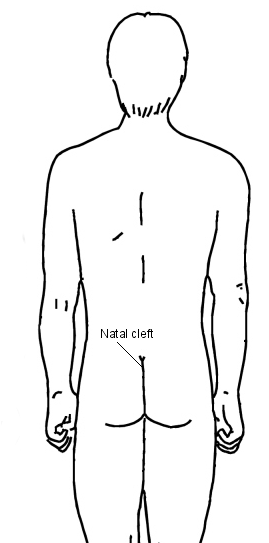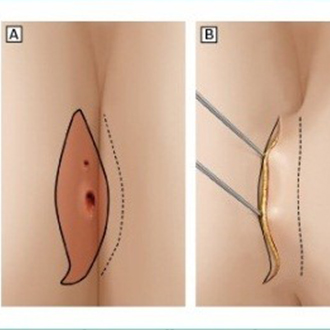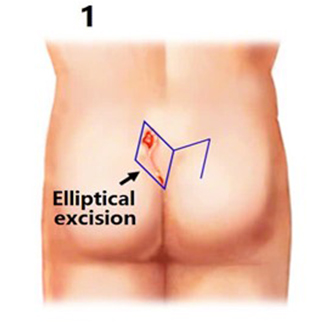A pilonidal sinus is an infected tract under the skin between the buttocks. Treatment commonly involves an operation. After the operation you should keep the area free of growing hair by regular shaving or other means of hair removal

Pilonidal Sinus
What is a Pilonidal Sinus?
Pilonidal means a ‘nest of hairs’
A sinus tract is a narrow tunnel (a small abnormal channel) in your body. A sinus tract typically goes between a focus of infection in deeper tissues to your skin surface. This means that the tract may discharge pus from time to time on to your skin.
A pilonidal sinus is a sinus tract which commonly contains hairs. It occurs under your skin between your buttocks (the natal cleft) a short distance above your back passage (anus). The sinus tract goes in a vertical direction between your buttocks. Rarely, a pilonidal sinus occurs in other sites of your body

What causes a Pilonidal Sinus?
The exact cause is not clear. There are various theories. For example, one theory is that the problem may develop from a minor abnormality you were born with, in the skin between the buttocks. This may explain why the condition tends to run in some families. Part of the abnormality in this part of your skin may be that the hairs grow into your skin rather than outwards.
Another theory is that you develop skin dimples (skin pits) in the skin between your buttocks. These may develop as a result of local pressure or friction causing damage to the small structures below your skin which are responsible for making hairs (the hair follicles). Because of local pressure, growing hair in your natal cleft may become pushed into your skin pits.
Whatever the cause, once hair fragments become ‘stuck’ in your skin they irritate it and cause inflammation. Inflamed skin quickly becomes infected and so a repeated (recurrent) or persistent infection tends to develop in the affected area. The infection causes the sinus to develop which often contains broken pieces of hair.
(A similar condition can occur between the fingers of hairdressers, caused by customers’ hairs entering moist, damaged skin.)
Who develops a Pilonidal Sinus?
This condition affects around 26 in 100,000 people each year in the UK. It is rare in children and in people over the age of 40. It is four times more common in men than in women (as they are hairier than women).
Certain factors increase the risk of developing the condition and include:
- A job involving a lot of sitting (a sedentary occupation).
- Being overweight or obese.
- A previous persistent irritation or injury to the affected area.
- Having a hairy, deep natal cleft.
- A family history of the condition.
This condition used to be called ‘jeep seat’, as it was common in army jeep drivers. This was probably a result of many hours driving and ‘bouncing’ on a hard seat, which caused irritation, minor injury and pressure around the natal cleft.
What are the symptoms of a Pilonidal Sinus?
A pilonidal sinus may not cause any symptoms at first. You may not be aware that you have one. Some people notice a painless lump at first in the affected area when washing. However, in most cases, symptoms develop at some stage and can be ‘acute’ or ‘chronic’.
Rapid-onset (acute) symptoms
You may develop increasing pain and swelling over a number of days as a ball of pus with surrounding skin infection (an infected abscess) develops in and around the sinus. This can become very painful and tender.
Persistent (chronic) symptoms
Around 4 in 10 people have a repeated (recurrent) pilonidal sinus. You may develop some pain which is less intense than the acute symptoms. Usually the sinus discharges some pus. This releases the pressure and so the pain tends to ease off and not become severe. However, the infection never clears completely. This can mean that the symptoms of pain and discharge can last long-term, or flare up from time to time, until the sinus is treated by an operation.
What is the treatment for Pilonidal Sinus?
If you have no symptoms
If you have no symptoms then you will normally be advised to clear the affected area of hairs (by shaving, etc) and to keep the area clean with good personal hygiene.
If you have rapid-onset (acute) symptoms
If you have an infection then you may be given some medicines called antibiotics. Painkillers (such as paracetamol and/or ibuprofen) may be very helpful to improve the pain. It may be that you need to have an emergency operation. This procedure punctures (incises) and drains the ball of pus with the surrounding skin infection (abscess). This is usually done in hospital.
If you have persistent (chronic) symptoms
In most cases, an operation will be advised. There are various operations which are done to cure this problem. Your surgeon will be able to give the details and the pros and cons of each operation. The options include the following:
Wide excision and healing by secondary intention
This operation involves cutting out (excision of) the sinus but also cutting out a wide margin of skin which surrounds the sinus. The wound is not closed but just left open to heal by natural healing processes (healing by ‘secondary intention’). This usually requires several weeks of regular dressing changes until it heals fully. The advantage of this method is that all inflamed tissue is removed and the chance of the condition coming back (a recurrence) is low.
Excision and primary closure
This means taking out the section of skin which contains the sinus. This is done by cutting out an oval-shaped (ellipse) flap of skin either side of the sinus, which takes out the sinus. The two sides of the ellipse are then stitched together. The advantage for this is, if successful, the wound heals quite quickly. The risk of a recurrence or of developing a wound infection after the operation is higher than with the above procedure. This risk may be reduced by using a wound technique in which the line of stitches is moved away from between the buttocks.
A plastic surgery technique
In some cases, where the sinus recurs or is extensive, plastic surgery may be advised to remove the sinus and refashion the nearby skin.
There are variations on the above procedures, depending on your circumstances, the size and extent of the sinus, and whether it is a first or recurrent problem. Your surgeon will be able to discuss with you in detail the most suitable type of operation.
New techniques are being researched to try to improve the recovery after having an operation.
After your operation
Your surgeon will usually advise that the wound should be kept clean and any hair growing near it be shaved or removed by other means. Some surgeons recommend that, even when the wound is healed, you should keep the area free of hair growing by shaving every few weeks, or by other methods to remove the hair. This reduces the chance of the problem coming back (recurring)


